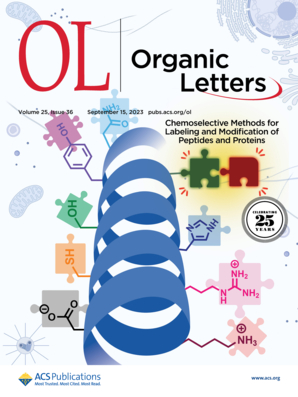Quinol-Enedione重排
IF 4.9
1区 化学
Q1 CHEMISTRY, ORGANIC
引用次数: 0
摘要
喹啉烯二酮重排使得从现成的对喹啉底物合成2-环己烯-1,4-二酮成为可能。在零星的早期报告的基础上,我们优化了反应条件,并系统地研究了其底物范围。强调了Brønsted酸介导反应条件对各种喹诺衍生物的效用,包括具有取代和未取代迁移末端的喹诺衍生物。值得注意的是,喹啉烯二酮和二烯酮-苯酚重排之间的动力学选择性被证明。烯二酮产品的合成潜力是通过一系列的转化,导致形成复杂的多环结构。这些发现为识别和应用合成中的醌烯二酮重排提供了一个有价值的框架,而计算研究为其机制基础提供了有价值的见解。本文章由计算机程序翻译,如有差异,请以英文原文为准。

Quinol–Enedione Rearrangement
The quinol–enedione rearrangement enables the synthesis of 2-cyclohexene-1,4-diones from readily available para-quinol substrates. Building on sporadic early reports of this transformation, we have optimized the reaction conditions and systematically investigated its substrate scope. The utility of Brønsted acid-mediated reaction conditions for a variety of quinol derivatives, including those with substituted and unsubstituted migrating termini, is highlighted. Notably, kinetic selectivity between quinol–enedione and dienone–phenol rearrangements is demonstrated. The synthetic potential of the enedione products is showcased through a range of transformations, leading to the formation of complex polycyclic structures. These findings provide a valuable framework for recognizing and applying the quinol–enedione rearrangement in synthesis, while computational studies offer valuable insights into its mechanistic underpinnings.
求助全文
通过发布文献求助,成功后即可免费获取论文全文。
去求助
来源期刊

Organic Letters
化学-有机化学
CiteScore
9.30
自引率
11.50%
发文量
1607
审稿时长
1.5 months
期刊介绍:
Organic Letters invites original reports of fundamental research in all branches of the theory and practice of organic, physical organic, organometallic,medicinal, and bioorganic chemistry. Organic Letters provides rapid disclosure of the key elements of significant studies that are of interest to a large portion of the organic community. In selecting manuscripts for publication, the Editors place emphasis on the originality, quality and wide interest of the work. Authors should provide enough background information to place the new disclosure in context and to justify the rapid publication format. Back-to-back Letters will be considered. Full details should be reserved for an Article, which should appear in due course.
 求助内容:
求助内容: 应助结果提醒方式:
应助结果提醒方式:


